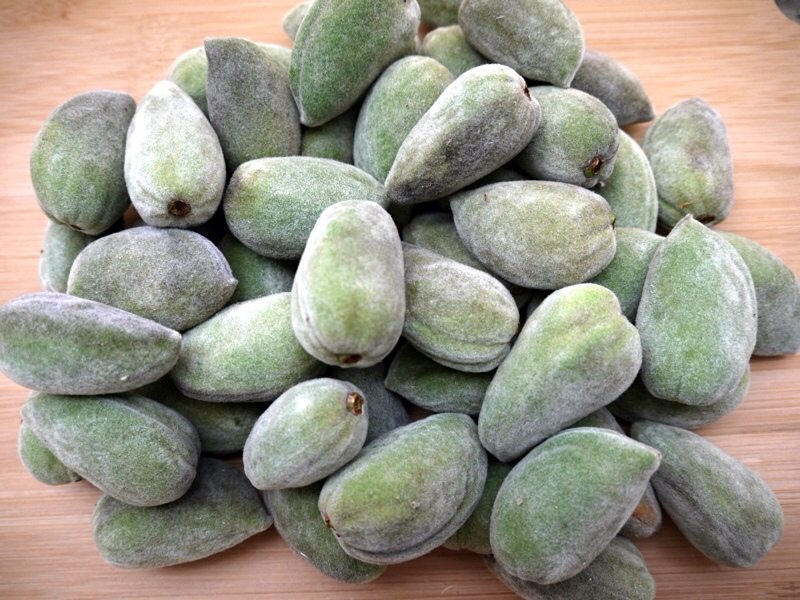There is nothing particularly unusual about this beautiful little strand of cherry tomatoes but I was confronted by whole display of them at a new produce store I was visiting and I couldn’t help myself, I bought half a kilo. I would catorgorize this as kitchen porn. Which brings up the larger question, how do specialty vegetable, meat, cheese and bakeries compete with supermarkets in Paris. The answer is presentation, quality, service and particularly beautiful or unusual items. In a supermarket these might be thrown into a bin, but at my produce store, they were carefully lined up and stacked to attract my attention. The green beans were presented in exactly the same way, a neat stack stretching 2-3 feet, a striking appearance as were the flat peaches (I should have taken a picture).
Everybody walks in the neighborhood here, no one drives to market (no parking). It is not unlike an open air shopping mall, except the anchors are the various little cafes where you have coffee (espresso) once or twice a day and three small supermarkets. As you go to market, you pass the bread store..beautiful aroma, the cheese shop…huge wheels of Brie, the butcher…mouthwatering cooked filet and the wonderful beauty of the fruit and vegetable store. As I picked my selections, half a kilo each of cherry tomatoes, striated beans and flat peaches, they were carefully lifted from their displays and placed in neat, little white bags, as if the owner was parting with little nuggets of gold. He nodded to me, as if to say, I approve of your selection. The cost was only 11 euros and it took 3 minutes. That is how they stay in business.
Green almonds are available for a brief 8 week period from late April to the middle of June, which is one of the reasons they have always been considered such a delicacy. Within the green almonds fuzzy shell lies a jelly like inside and a skinless, white almond with a gelatinous texture, similar to a firm grape. These white almonds have a subtle flavor that has been described as grassy or fruity.
I got these green almonds (picture above) today and it is a little late in the season. You can see that the hull is a little dried out around the almond and the white almond is solid as opposed to the picture to the left from “The Hungry Mouse” (again, another great name) in which the white almond is gelatinous in the middle. They seem to taste good though, very fresh, sort of like grass with citrus overtones. I even tried eating them whole with salt and they tasted pretty good. In defense of the ones I got, most of the pictures on the Internet are solid, like the ones I have.
In this relatively easy recipe from Alinea (a famous restaurant in Chicago and cookbook by chef Grant Achatz), green almonds are embedded in cucumber gelée and topped with sweet, spicy, sour, and salty elements. The crisp almonds, soft jelly, and four contrasting ingredients make for a pretty tasty treat. I got the picture to the right and the recipe at “Apple Pie, Patis and Pâté“, go there to get the recipe.
I found these “haricots a ecosser” at the same market as the tomatoes, I didn’t buy too many because I didn’t really know what they were. Once I understood that these beans were meant to be “shelled”, I shelled the lot and found out why the owner was surprised I took so few. I grew up on a sort of farm but we only grew string beans, or as the French call them haricot verts. I have only seen these in dry form but in the US, these are called cranberry beans, because of their brilliant scarlet pods and are the most commonly available shelling beans.
According to Clifford A White, the green bean was introduced to the Mediterranean upon the return of Columbus from his second voyage to the New World in 1493. In Columbus’s diary from November 4, 1492 he describes lands in Cuba planted with faxones and fabas “different than ours.” Later he encounterd fexoes and habasthat were different than the ones he knew from Spain. Faxones was probably the cowpea and fabasand habas was the fava bean. The beans Columbus found were undoubtedly what is now designated Phaseolus vulgaris, the common green bean.
The Cranberry Bean was first cultivated by the Aztecs and the Incas thousands of years ago. It’s believed to have been crossed with the white bean to create today’s larger, kidney-shaped Cranberry Bean. It was brought to Italy in the 1500?s and has thrived there ever since.
I found this nice recipe for “fresh shelling bean salad” at david lebowitz (picture above) and after I buy some additional beans tomorrow I am going to make it.









